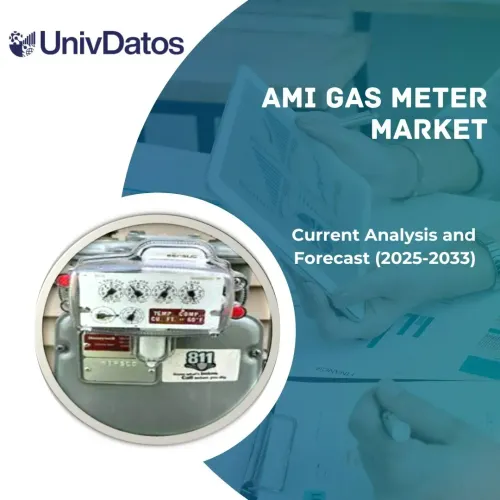- الرئيسية
- معلومات عنا
- صناعة
- الخدمات
- قراءة
- اتصل بنا
تحول الهند الرقمي في سوق الطاقة: التحليل الحالي والتوقعات (2024-2032)
التركيز على التكنولوجيا (تحليلات البيانات الضخمة، الذكاء الاصطناعي، نظام التحكم الصناعي، الأجهزة الميدانية، الواقع الممتد، إنترنت الأشياء)؛ التطبيق (النفط والغاز، توليد الطاقة، المرافق، أخرى)؛ والمنطقة
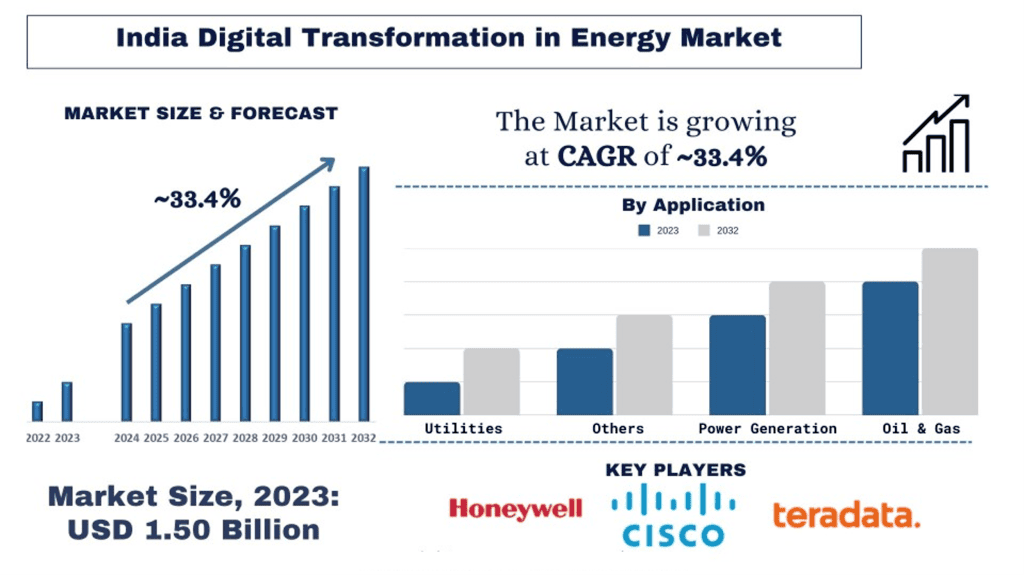
حجم سوق التحول الرقمي في قطاع الطاقة في الهند والتوقعات
بلغت قيمة سوق التحول الرقمي في قطاع الطاقة في الهند 1.50 مليار دولار أمريكي في عام 2023 ومن المتوقع أن ينمو بمعدل نمو سنوي مركب قدره 33.4٪.
تحليل سوق التحول الرقمي في قطاع الطاقة في الهند
سجلت الهند حصة سوقية كبيرة في سوق التحول الرقمي في قطاع الطاقة في الهند ومن المتوقع أن تشهد معدل نمو سنوي مركب مؤثر في الفترة المتوقعة. تتسابق الاقتصادات الهندية لتنويع محافظها في مجال الطاقة لتحقيق التوازن بين أمن الطاقة والتزامات الاستدامة مع تلبية متطلبات الطاقة لاقتصاداتها وسكانها المتزايدين. أحد العوامل الدافعة لزيادة الطاقة المتجددة هو اتفاقيات شراء الطاقة للشركات (PPAs). بموجب الاتفاقيات، تشتري الشركات الكهرباء مباشرة من منتجي الطاقة. تستثمر العديد من الشركات بكثافة في الطاقة المتجددة وتسهل نمو الرقمنة في قطاع الطاقة. على سبيل المثال - تستثمر أمازون في مشروع للطاقة الشمسية على نطاق المرافق بقدرة 62 ميجاوات في سنغافورة. عند الانتهاء منه، سيكون مشروع أمازون من بين أكبر أنظمة الطاقة الشمسية المتنقلة المجمعة المصممة والمنشأة في سنغافورة وسيساهم بطاقة متجددة جديدة في شبكة الكهرباء الوطنية. ستعمل 80,000 ميجاوات في الساعة (MWh) من الطاقة النظيفة المتولدة سنويًا على تشغيل مكاتب أمازون ومراكز البيانات ومرافق التنفيذ في سنغافورة. تستهدف أمازون تشغيل عملياتها بنسبة 100 بالمائة من الطاقة المتجددة بحلول عام 2030.
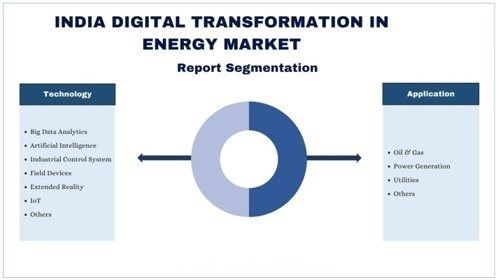
اتجاهات سوق التحول الرقمي في قطاع الطاقة في الهند
يناقش هذا القسم اتجاهات السوق الرئيسية التي تؤثر على القطاعات المختلفة من سوق التحول الرقمي في قطاع الطاقة في الهند كما حددها فريق خبراء الأبحاث لدينا.
تحليلات البيانات الضخمة في التحول الرقمي في قطاع الطاقة
تشير تحليلات البيانات الضخمة إلى جمع وتحليل وتفسير كميات كبيرة من البيانات للكشف عن الأنماط والاتجاهات. يمكن أن تحقق البيانات الضخمة في قطاع الطاقة العديد من الفوائد، بما في ذلك تحسين الكفاءة التشغيلية وخفض التكاليف وزيادة رضا العملاء وتحسين إنتاج الطاقة. أدى دمج تحليلات البيانات الضخمة لشركات الكهرباء إلى إحداث ثورة في كيفية توزيع الكهرباء وإدارتها في الشبكة. من خلال تحليل البيانات من العدادات الذكية وأجهزة الاستشعار الأخرى، يمكن لشركات المرافق الحصول على رؤى قيمة حول الأداء في الوقت الفعلي للشبكة، وتحديد ومعالجة المشكلات مثل الانقطاعات وسرقة الطاقة. لا تعمل إدارة الشبكة الذكية على تحسين الكفاءة الكلية للشبكة فحسب، بل تعزز أيضًا موثوقية ومرونة إمدادات الطاقة.
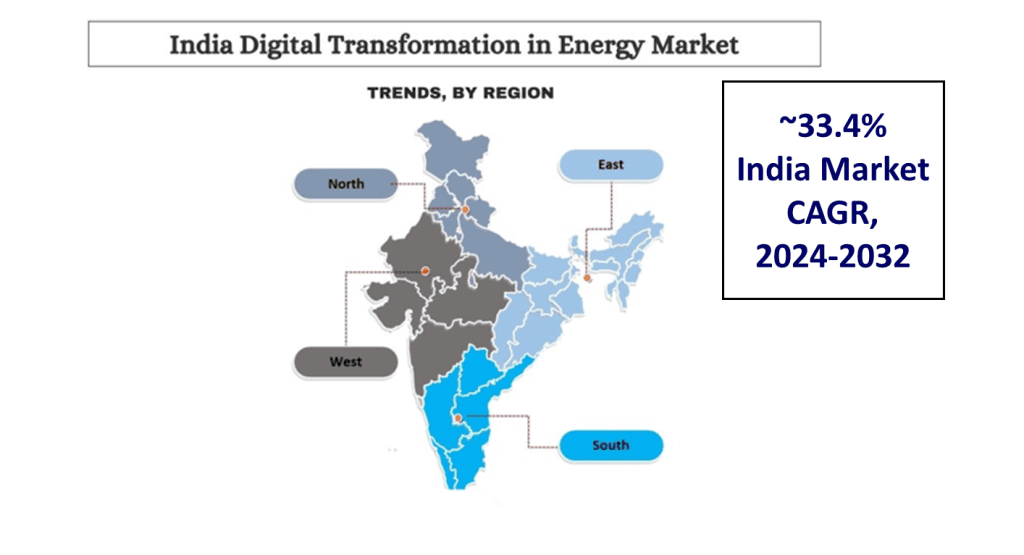
من المتوقع أن تنمو الهند بمعدل نمو سنوي مركب كبير خلال الفترة المتوقعة
في قمة غلاسكو في عام 2021، أعلنت الهند عن عزمها زيادة قدرتها من الوقود غير الأحفوري إلى أكثر من 500 جيجاوات بحلول عام 2030 و 50٪ من إجمالي قدرة توليد الطاقة المركبة بحلول نفس العام. علاوة على ذلك، بدأت العديد من شركات الطاقة في الهند في تنفيذ الرقمنة للوصول إلى القدرة المخطط لها. على سبيل المثال، وقعت REC (المعروفة سابقًا باسم شركة كهرباء الريف المحدودة)، وهي شركة تابعة للقطاع العام (PSU) من نوع "ماهاراتنا" تابعة لوزارة الطاقة، مذكرة تفاهم مع شركة National Informatics Centre Services Inc. (NICSI). وسيتعاونون في مجموعة من خدمات تكنولوجيا المعلومات والاتصالات (ICT) والتحول الرقمي. ومن المتوقع أن تعزز مذكرة التفاهم النظام البيئي REC من خلال تمكين استكشاف التقنيات المتطورة مثل إنترنت الأشياء (IoT) والذكاء الاصطناعي (AI) والتعلم الآلي وتحليلات البيانات وتقنية blockchain والأمن السيبراني.
نظرة عامة على قطاع التحول الرقمي في قطاع الطاقة في الهند
يتسم سوق التحول الرقمي في قطاع الطاقة في الهند بالتنافسية والتشتت، مع وجود العديد من اللاعبين في السوق العالميين والدوليين. يتبنى اللاعبون الرئيسيون استراتيجيات نمو مختلفة لتعزيز وجودهم في السوق، مثل الشراكات والاتفاقيات والتعاون وإطلاق منتجات جديدة والتوسعات الجغرافية وعمليات الاندماج والاستحواذ. بعض اللاعبين الرئيسيين العاملين في السوق هم شنايدر إلكتريك إس إي؛ وهانيويل إنترناشونال إنك؛ وروكويل أوتوميشن إنك؛ و SAP؛ و ABB؛ وآي بي إم كوربوريشن؛ ومايكروسوفت؛ وسيسكو سيستمز إنك؛ وتيراداتا؛ وإنتل كوربوريشن.
اختراق الطاقة المتجددة كنسبة مئوية من التوليد والحمل
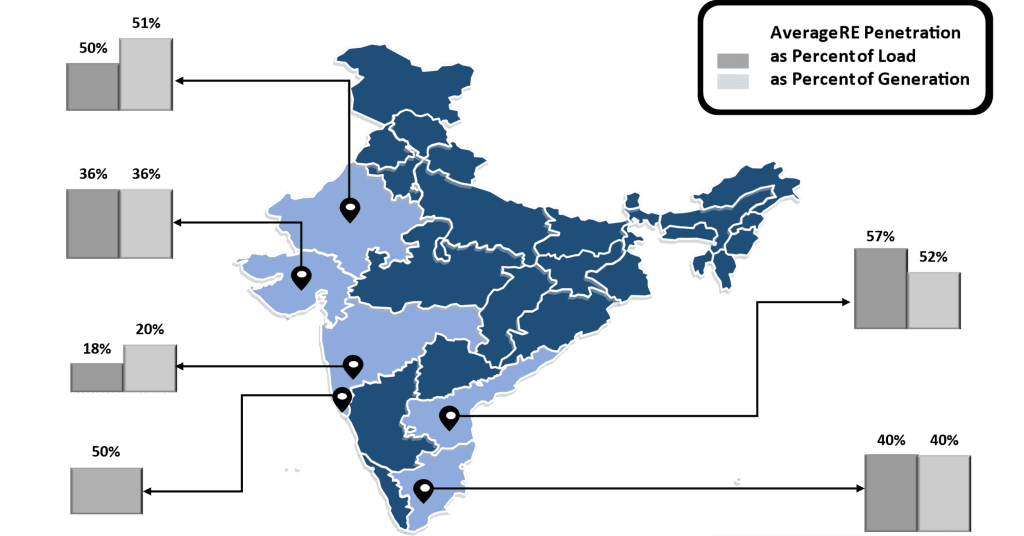
تغطية تقرير سوق التحول الرقمي في قطاع الطاقة في الهند
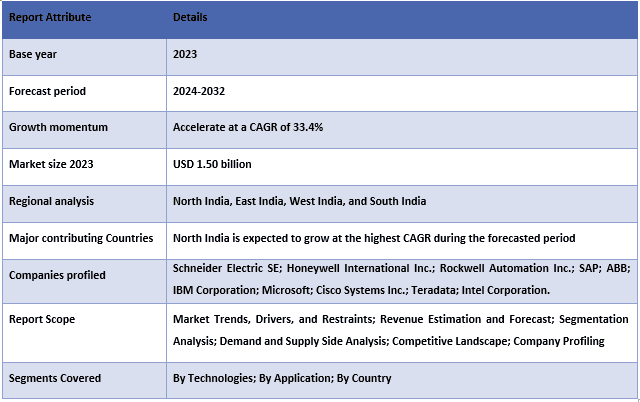
أسباب شراء هذا التقرير:
- تتضمن الدراسة تحليل لحجم السوق والتنبؤ به تم التحقق منه من قبل خبراء الصناعة الرئيسيين الموثوق بهم.
- يقدم التقرير مراجعة سريعة للأداء العام للصناعة في لمحة واحدة.
- يغطي التقرير تحليلًا متعمقًا لنظرائهم البارزين في الصناعة مع التركيز الأساسي على البيانات المالية الرئيسية للأعمال ومحافظ المنتجات واستراتيجيات التوسع والتطورات الحديثة.
- فحص تفصيلي للدوافع والقيود والاتجاهات الرئيسية والفرص السائدة في الصناعة.
- تغطي الدراسة السوق بشكل شامل عبر قطاعات مختلفة.
- تحليل متعمق على المستوى الإقليمي للصناعة.
خيارات التخصيص:
يمكن تخصيص سوق التحول الرقمي في قطاع الطاقة في الهند بشكل أكبر وفقًا للمتطلبات أو أي قطاع آخر في السوق. إلى جانب ذلك، تدرك UMI أن لديك احتياجات عمل خاصة بك، لذا لا تتردد في الاتصال بنا للحصول على تقرير يناسب متطلباتك تمامًا.
جدول المحتويات
منهجية البحث لتحليل سوق التحول الرقمي في قطاع الطاقة في الهند (2024-2032)
كان تحليل السوق التاريخي، وتقدير السوق الحالي، والتنبؤ بالسوق المستقبلي للتحول الرقمي في سوق الطاقة في الهند هي الخطوات الرئيسية الثلاث التي تم اتخاذها لإنشاء وتحليل تبني التحول الرقمي في قطاع الطاقة في المناطق الرئيسية. تم إجراء بحث ثانوي شامل لجمع أرقام السوق التاريخية وتقدير حجم السوق الحالي. ثانيًا، للتحقق من صحة هذه الرؤى، تم أخذ العديد من النتائج والافتراضات في الاعتبار. علاوة على ذلك، تم إجراء مقابلات أولية شاملة أيضًا، مع خبراء الصناعة عبر سلسلة القيمة لسوق التحول الرقمي في قطاع الطاقة في الهند. بعد افتراض والتحقق من صحة أرقام السوق من خلال المقابلات الأولية، استخدمنا نهجًا من أعلى إلى أسفل/من أسفل إلى أعلى للتنبؤ بحجم السوق الكامل. بعد ذلك، تم اعتماد طرق تقسيم السوق وتثليث البيانات لتقدير وتحليل حجم سوق القطاعات والقطاعات الفرعية المتعلقة بالصناعة. تم شرح المنهجية التفصيلية أدناه:
تحليل حجم السوق التاريخي
الخطوة 1: دراسة متعمقة للمصادر الثانوية:
تم إجراء دراسة ثانوية مفصلة للحصول على حجم السوق التاريخي للتحول الرقمي الهندي في سوق الطاقة من خلال مصادر الشركة الداخلية مثل التقارير السنوية والبيانات المالية وعروض الأداء والإصدارات الصحفية وما إلى ذلك، والمصادر الخارجية بما في ذلك المجلات والأخبار والمقالات والمنشورات الحكومية ومنشورات المنافسين وتقارير القطاع وقاعدة بيانات الطرف الثالث والمنشورات الموثوقة الأخرى.
الخطوة 2: تجزئة السوق:
بعد الحصول على حجم السوق التاريخي للتحول الرقمي في سوق الطاقة في الهند، أجرينا تحليلًا ثانويًا مفصلاً لجمع رؤى السوق التاريخية وحصتها للقطاعات والقطاعات الفرعية المختلفة للمناطق الرئيسية. يتم تضمين القطاعات الرئيسية في التقرير كتقنيات وتطبيقات. علاوة على ذلك، تم إجراء تحليلات على المستوى القطري لتقييم التبني الكلي لنماذج الاختبار في تلك المنطقة.
الخطوة 3: تحليل العوامل:
بعد الحصول على حجم السوق التاريخي للقطاعات والقطاعات الفرعية المختلفة، أجرينا تحليلًا تفصيليًا للعوامل لتقدير حجم السوق الحالي للتحول الرقمي في سوق الطاقة في الهند. علاوة على ذلك، أجرينا تحليلًا للعوامل باستخدام متغيرات تابعة ومستقلة مثل تقنيات وتطبيق التحول الرقمي في سوق الطاقة في الهند. تم إجراء تحليل شامل لسيناريوهات جانب الطلب والعرض مع الأخذ في الاعتبار أهم الشراكات وعمليات الدمج والاستحواذ وتوسيع الأعمال وإطلاق المنتجات في قطاع التحول الرقمي في سوق الطاقة في الهند على مستوى العالم.
تقدير وحجم السوق الحالي والتوقعات
تحديد حجم السوق الحالي: بناءً على رؤى قابلة للتنفيذ من الخطوات الثلاث المذكورة أعلاه، توصلنا إلى حجم السوق الحالي واللاعبين الرئيسيين في سوق التحول الرقمي في الطاقة في الهند والحصص السوقية للقطاعات. تم تحديد جميع النسب المئوية المطلوبة وتقسيمات السوق باستخدام النهج الثانوي المذكور أعلاه وتم التحقق منها من خلال المقابلات الأولية.
التقدير والتنبؤ: لتقدير السوق والتنبؤ به، تم تعيين أوزان لعوامل مختلفة بما في ذلك المحركات والاتجاهات والقيود والفرص المتاحة لأصحاب المصلحة. بعد تحليل هذه العوامل، تم تطبيق تقنيات التنبؤ ذات الصلة، أي النهج من أعلى إلى أسفل/من أسفل إلى أعلى، للوصول إلى توقعات السوق لعام 2030 للقطاعات والقطاعات الفرعية المختلفة عبر الأسواق الرئيسية على مستوى العالم. تتضمن منهجية البحث المعتمدة لتقدير حجم السوق ما يلي:
- حجم سوق الصناعة، من حيث الإيرادات (بالدولار الأمريكي) ومعدل تبني التحول الرقمي في سوق الطاقة في الهند عبر الأسواق الرئيسية محليًا
- جميع النسب المئوية والتقسيمات والتحليلات التفصيلية لقطاعات السوق وقطاعاته الفرعية
- اللاعبون الرئيسيون في سوق التحول الرقمي في الطاقة في الهند من حيث المنتجات المقدمة. أيضًا، استراتيجيات النمو التي يتبناها هؤلاء اللاعبون للتنافس في السوق سريع النمو.
التحقق من صحة حجم السوق والحصة السوقية
البحث الأولي: تم إجراء مقابلات متعمقة مع قادة الرأي الرئيسيين (KOLs) بما في ذلك كبار المديرين التنفيذيين (CXO/VPs، رئيس المبيعات، رئيس التسويق، رئيس العمليات، الرئيس الإقليمي، الرئيس القطري، إلخ) عبر المناطق الرئيسية. ثم تم تلخيص نتائج البحث الأولي، وإجراء تحليل إحصائي لإثبات الفرضية المذكورة. تم دمج المدخلات من البحث الأولي مع النتائج الثانوية، وبالتالي تحويل المعلومات إلى رؤى قابلة للتنفيذ.
تقسيم المشاركين الرئيسيين في المناطق المختلفة
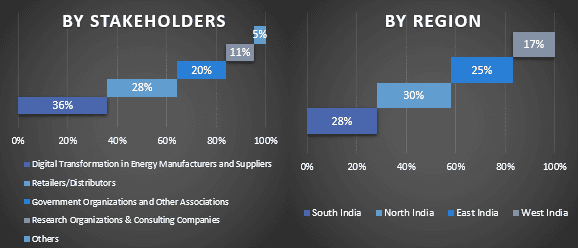
هندسة السوق
تم استخدام تقنية تثليث البيانات لإكمال تقدير السوق الإجمالي والوصول إلى أرقام إحصائية دقيقة لكل قطاع وقطاع فرعي من قطاعات التحول الرقمي في سوق الطاقة في الهند. تم تقسيم البيانات إلى عدة قطاعات وقطاعات فرعية بعد دراسة المعايير والاتجاهات المختلفة في مجالات التقنيات والتطبيقات في التحول الرقمي في سوق الطاقة في الهند.
الهدف الرئيسي من دراسة سوق التحول الرقمي في الطاقة في الهند
تم تحديد اتجاهات السوق الحالية والمستقبلية للتحول الرقمي في سوق الطاقة في الهند في الدراسة. يمكن للمستثمرين الحصول على رؤى استراتيجية لترسيخ تقديرهم للاستثمارات على التحليل النوعي والكمي الذي تم إجراؤه في الدراسة. حددت اتجاهات السوق الحالية والمستقبلية الجاذبية الإجمالية للسوق على المستوى الإقليمي، مما يوفر منصة للمشارك الصناعي لاستغلال السوق غير المستغلة للاستفادة من ميزة المبادرة الأولى. تشمل الأهداف الكمية الأخرى للدراسات ما يلي:
- تحليل حجم السوق الحالي والمتوقع للتحول الرقمي في سوق الطاقة في الهند من حيث القيمة (بالدولار الأمريكي). أيضًا، قم بتحليل حجم السوق الحالي والمتوقع للقطاعات والقطاعات الفرعية المختلفة.
- تشمل القطاعات في الدراسة مجالات التقنيات والتطبيقات.
- تحديد وتحليل الإطار التنظيمي للتحول الرقمي في الطاقة في الهند
- تحليل سلسلة القيمة المعنية بوجود وسطاء مختلفين، جنبًا إلى جنب مع تحليل سلوكيات العملاء والمنافسين في الصناعة.
- تحليل حجم السوق الحالي والمتوقع للتحول الرقمي في سوق الطاقة في الهند للمنطقة الرئيسية.
- ملفات تعريف الشركات للتحول الرقمي في سوق الطاقة في الهند واستراتيجيات النمو التي يتبناها اللاعبون في السوق للاستمرار في السوق سريع النمو.
- تحليل متعمق على المستوى الإقليمي للصناعة
الأسئلة الشائعة الأسئلة الشائعة
س1: ما هو حجم السوق الحالي وإمكانات النمو لتحول الطاقة الرقمي في الهند؟
س2: ما هي العوامل الدافعة لنمو التحول الرقمي في سوق الطاقة في الهند؟
س3: أي قطاع لديه الحصة الأكبر من سوق التحول الرقمي للطاقة في الهند حسب التطبيق؟
س 4: ما هي التقنيات والاتجاهات الناشئة في سوق التحول الرقمي للطاقة في الهند؟
س5: أي منطقة ستسيطر على سوق التحول الرقمي في قطاع الطاقة في الهند؟
ذات صلة التقارير
العملاء الذين اشتروا هذا المنتج اشتروا أيضًا






